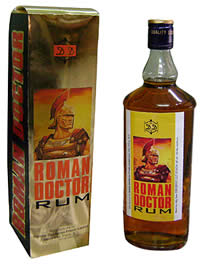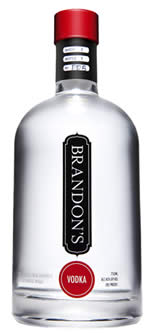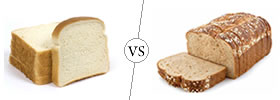Difference between Rum and Vodka
Key Difference: Rums are distilled alcoholic beverages made from sugarcane byproducts such as molasses or sugarcane juices. Similar to most alcoholic beverages, rums must go through the process of distillation, fermentation and aging. Vodka is a distilled spirit that is composed of water and ethanol. It is made by distilling juices from various fermented substances such as grains, potatoes and sometimes sugar or fruit. Vodka has a distinct taste of spirit as it is only composed of ethanol and water, so the clear taste of ethanol is present. Rum is sweeter compared to vodka because of it being derived from molasses or sugarcane juice.
Rum and Vodka are two different types of alcoholic beverages that are consumed in today’s society. Both are popular beverages and can often confuse people that are just stepping into the world of different alcohols. For many people all alcoholic beverages are only there for one reason, to get drunk. However, there are many aficionados that consume alcoholic beverages for the taste, the aroma and the flavor. Rum and Vodka contain different ingredients, go through different processes and have different flavors and aroma.
 Rums are distilled alcoholic beverages made from sugarcane byproducts such as molasses or sugarcane juices. Similar to most alcoholic beverages, rums must go through the process of distillation, fermentation and aging. Depending on the geographical region of the product, rums differ in taste, color and strength. The origin of the term ‘rum’ is unclear and there are various different possibilities as to how the name came by. British etymologist, Samuel Morewood in his 1824 essay stated that the word ‘rum’ was a British slang term from “the best”. Morewood also suggested another possibility that the word was taken from the last syllable of the Latin word, “saccharum”, meaning “sugar”. Other possibilities include the word being derived from other popular British drinks of the time such as ramboozle and rumfustian.
Rums are distilled alcoholic beverages made from sugarcane byproducts such as molasses or sugarcane juices. Similar to most alcoholic beverages, rums must go through the process of distillation, fermentation and aging. Depending on the geographical region of the product, rums differ in taste, color and strength. The origin of the term ‘rum’ is unclear and there are various different possibilities as to how the name came by. British etymologist, Samuel Morewood in his 1824 essay stated that the word ‘rum’ was a British slang term from “the best”. Morewood also suggested another possibility that the word was taken from the last syllable of the Latin word, “saccharum”, meaning “sugar”. Other possibilities include the word being derived from other popular British drinks of the time such as ramboozle and rumfustian.
Majority of the rum in the world is produced in the Caribbean and Latin America, with selected other countries such as India, Spain, New Zealand, Mexico, etc. also partaking in producing the beverage. Rum was first distilled on a sugarcane plantation in the Caribbean during the 17th century. The slaves at the plantation discovered that molasses, a byproduct of sugarcane when it is refined into suger, could be fermented into alcohol. Other places to record early rum distillation include Brazil and Barbados. After the development of rum, it grew fast in demand and it was also used in many places as currency. To support the increasing demand of sugar, labor was required to work the sugar plantations. This resulted in the establishment of the triangular trade between Africa, the Caribbean and the European colonies. Rum also became popular with seamen and pirates.
Rum does not have any set production methods, with the methods varying depending on the region where the distillers are located. Similar to some other alcoholic beverages, rum goes through the process of fermentation of either molasses or sugarcane juice. During fermentation, the water and yeast is added to the base ingredient, allowing the yeast to break down the sugar. Depending on the type of yeast used for fermentation, the taste and aroma of the rum varies. After distillation, the rum is then put through the process of distillation. After distillation, the rum is required to be aged for at least one year in many countries. The aging process could be done in wooden casks (natural or charred) as well as in stainless steel tanks. The rum in the wooden casks is darker in appearance, while the rum in stainless steel tanks remains colorless. Caramel can also be added to rum to adjust the color of the final product before it is bottled.
According to Wikipedia, rum comes in certain grades and variations. They can be classified under the following:
- Light rums: Light rums are rums that are light or clear in color. They can also be referred to as white rum. They have very little flavor and are used in cocktails.
- Gold rums: Gold rums are also known as amber rums. They are often aged in charred white oak barrels. They have a stronger flavor compared to light rums.
- Dark rums: These are darker in color such as black, red or brown. They are aged for a longer period of time in heavily charred barrels. They may also have a hint of spices and caramel to adjust the color and flavoring. They are stronger and sweeter compared to the light and gold rums.
- Spiced rums: These rums obtain the flavor from spices or caramel. They are dark in color and may have spices such as cinnamon, rosemary, absinthe/aniseed, or pepper.
- Flavored rums: These rums are infused with additional flavors such as banana, coconut, citrus, etc.
- Overproof rums: These rums are higher in proof and ABV.
- Premium rums: These rums are high priced and are carefully aged and produced. They are said to have more flavor and taste.
 Vodka is a distilled spirit that is composed of water and ethanol. It is made by distilling juices from various fermented substances such as grains, potatoes and sometimes sugar or fruit. The distillation from sugar and fruit are also sold as flavored vodka. Vodkas were introduced in the United States after 1940s, before this time it was sold in countries such as Belarusian, Polish, Russian and Lithuanian. The traditional vodkas are 40% alcohol by volume (ABV) or 80 proof. In European Union, requires vodkas to have minimum 37.5% ABV for any "European vodka" to be known as vodka. The United States requires minimum 30%.
Vodka is a distilled spirit that is composed of water and ethanol. It is made by distilling juices from various fermented substances such as grains, potatoes and sometimes sugar or fruit. The distillation from sugar and fruit are also sold as flavored vodka. Vodkas were introduced in the United States after 1940s, before this time it was sold in countries such as Belarusian, Polish, Russian and Lithuanian. The traditional vodkas are 40% alcohol by volume (ABV) or 80 proof. In European Union, requires vodkas to have minimum 37.5% ABV for any "European vodka" to be known as vodka. The United States requires minimum 30%.
The term ‘vodka’ is derived from the Slavic word voda (water) and is often believed to refer to vodka as little water due to its clear color. Traditionally, vodka was a drink that was expected to be consumed neat (without any additives) in the vodka belt countries of Eastern Europe. However, these days vodka plays a main ingredient in many cocktails including Bloody Mary, Screwdriver, Sex on the Beach, Moscow Mule, White Russian, Black Russian, etc. It can also be consumed with soft drinks or is often great for mixing with gin and tonic.
Rums are available in a variety of colors such as white, amber, red and brown. On the other hand, vodkas are only available in white color. Vodka has a distinct taste of spirit as it is only composed of ethanol and water, so the clear taste of ethanol is present. Rum is sweeter compared to vodka because of it being derived from molasses or sugarcane juice. Rums can also have additional flavors such as spices or caramel. Vodkas are also available in additional flavors such as lemon, apple, orange, etc. Rum can also be added to foods to give it a certain taste. Both, rum and vodka can be consumed neat or can be an ingredient for cocktails.
Image Courtesy: liquorindia.com, drinkhacker.com









Add new comment